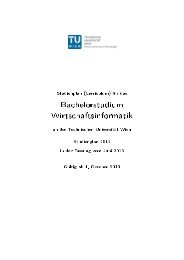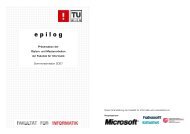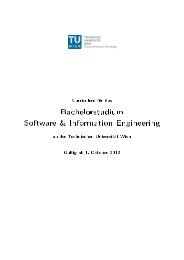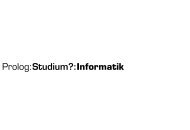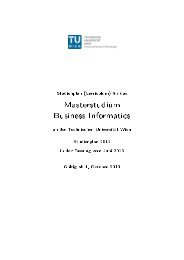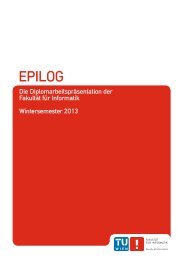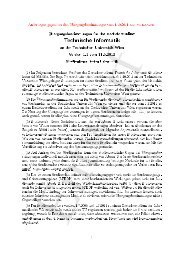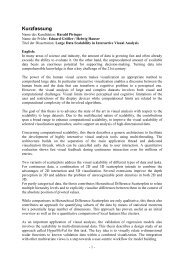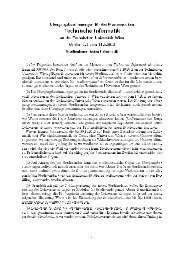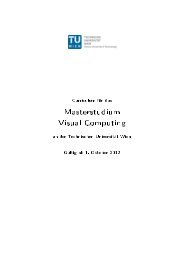Abstract-Band - Fakultät für Informatik, TU Wien - Technische ...
Abstract-Band - Fakultät für Informatik, TU Wien - Technische ...
Abstract-Band - Fakultät für Informatik, TU Wien - Technische ...
Sie wollen auch ein ePaper? Erhöhen Sie die Reichweite Ihrer Titel.
YUMPU macht aus Druck-PDFs automatisch weboptimierte ePaper, die Google liebt.
specialized as they need a lot of prior knowledge and often the results have<br />
to be corrected manually. An alternative to automatic and semi-automatic<br />
methods is to perform the segmentation manually. The main drawbacks of<br />
this approach are that it is very tedious and time consuming, the user<br />
knowledge has a very high impact on the results and it is very hard to<br />
reproduce specific results. This work presents a tool that enables the user to<br />
enhance results of automatic and semi-automatic algorithms and to do fast<br />
manual segmentation of shapes of arbitrary topology from scratch. The tool<br />
can deal with three and four dimensional image datasets captured by<br />
different modalities. The segmentation is mesh based and performed with a<br />
2D cut approach. To achieve a better alignment of the edges to a specific<br />
shape the edge class based Sticky Edges algorithm is introduced.<br />
Furthermore, well known mesh optimization algorithms were implemented to<br />
accomplish better results. To achieve a faster segmentation of 4D datasets<br />
two methods are presented. With the rst one the user can record its<br />
interactions on one volume in the 4D dataset and apply them automatically to<br />
the other volumes. The other one enables the user set an already segmented<br />
mesh as start position for the segmentation of other volumes. The approach<br />
presented in this work is up to 25 times faster than the evaluation approach.<br />
Moreover, the mesh quality regarding smoothness, curvature and triangle<br />
quality are at eye level with the evaluation meshes. The geometric distance to<br />
the ground truth meshes is on average 2 mm and the normal deviation is<br />
between 0.3 and 0.4 degree.<br />
Axel Goldmann<br />
Towards GPU Speech Coding<br />
Studium: Masterstudium Medieninformatik<br />
Betreuer: Associate Prof. Dr. Michael Wimmer<br />
Speech transmission is the central service in many telecommunication<br />
infrastructures. The encoding of many channels according to modern<br />
standards requires a fair amount of processing capacity. With the recent GPU<br />
product lines, powerful platforms have become available as supplement to<br />
desktop CPUs. This thesis tries to leverage these developments and examines<br />
the possibilities of general purpose GPU employment in the context of<br />
speech coding. The speech codec used in the TETRA mobile radio system is<br />
implemented using the CUDA programming model. The main question is,<br />
how many channels can be encoded in real time on current GPUs. Results<br />
show that through careful implementation and with some effort, a substial<br />
number of channels can be processed. It seems however that modern<br />
multicore CPUs are much better qualified for the task. The presented<br />
optimizations are far from complete and further research directions are<br />
suggested.<br />
40



